Zhu Liu
RefTok: Reference-Based Tokenization for Video Generation
Jul 03, 2025Abstract:Effectively handling temporal redundancy remains a key challenge in learning video models. Prevailing approaches often treat each set of frames independently, failing to effectively capture the temporal dependencies and redundancies inherent in videos. To address this limitation, we introduce RefTok, a novel reference-based tokenization method capable of capturing complex temporal dynamics and contextual information. Our method encodes and decodes sets of frames conditioned on an unquantized reference frame. When decoded, RefTok preserves the continuity of motion and the appearance of objects across frames. For example, RefTok retains facial details despite head motion, reconstructs text correctly, preserves small patterns, and maintains the legibility of handwriting from the context. Across 4 video datasets (K600, UCF-101, BAIR Robot Pushing, and DAVIS), RefTok significantly outperforms current state-of-the-art tokenizers (Cosmos and MAGVIT) and improves all evaluated metrics (PSNR, SSIM, LPIPS) by an average of 36.7% at the same or higher compression ratios. When a video generation model is trained using RefTok's latents on the BAIR Robot Pushing task, the generations not only outperform MAGVIT-B but the larger MAGVIT-L, which has 4x more parameters, across all generation metrics by an average of 27.9%.
DEAL: Data-Efficient Adversarial Learning for High-Quality Infrared Imaging
Mar 02, 2025

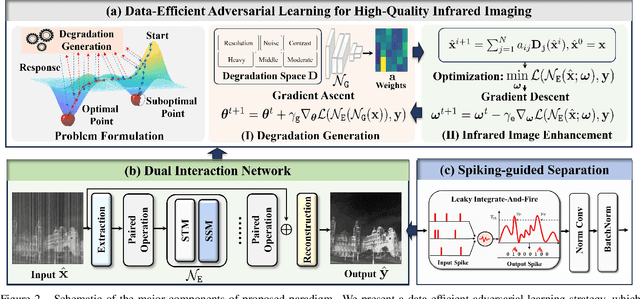

Abstract:Thermal imaging is often compromised by dynamic, complex degradations caused by hardware limitations and unpredictable environmental factors. The scarcity of high-quality infrared data, coupled with the challenges of dynamic, intricate degradations, makes it difficult to recover details using existing methods. In this paper, we introduce thermal degradation simulation integrated into the training process via a mini-max optimization, by modeling these degraded factors as adversarial attacks on thermal images. The simulation is dynamic to maximize objective functions, thus capturing a broad spectrum of degraded data distributions. This approach enables training with limited data, thereby improving model performance.Additionally, we introduce a dual-interaction network that combines the benefits of spiking neural networks with scale transformation to capture degraded features with sharp spike signal intensities. This architecture ensures compact model parameters while preserving efficient feature representation. Extensive experiments demonstrate that our method not only achieves superior visual quality under diverse single and composited degradation, but also delivers a significant reduction in processing when trained on only fifty clear images, outperforming existing techniques in efficiency and accuracy. The source code will be available at https://github.com/LiuZhu-CV/DEAL.
Exploring the Small World of Word Embeddings: A Comparative Study on Conceptual Spaces from LLMs of Different Scales
Feb 17, 2025Abstract:A conceptual space represents concepts as nodes and semantic relatedness as edges. Word embeddings, combined with a similarity metric, provide an effective approach to constructing such a space. Typically, embeddings are derived from traditional distributed models or encoder-only pretrained models, whose objectives directly capture the meaning of the current token. In contrast, decoder-only models, including large language models (LLMs), predict the next token, making their embeddings less directly tied to the current token's semantics. Moreover, comparative studies on LLMs of different scales remain underexplored. In this paper, we construct a conceptual space using word embeddings from LLMs of varying scales and comparatively analyze their properties. We establish a network based on a linguistic typology-inspired connectivity hypothesis, examine global statistical properties, and compare LLMs of varying scales. Locally, we analyze conceptual pairs, WordNet relations, and a cross-lingual semantic network for qualitative words. Our results indicate that the constructed space exhibits small-world properties, characterized by a high clustering coefficient and short path lengths. Larger LLMs generate more intricate spaces, with longer paths reflecting richer relational structures and connections. Furthermore, the network serves as an efficient bridge for cross-lingual semantic mapping.
GLTW: Joint Improved Graph Transformer and LLM via Three-Word Language for Knowledge Graph Completion
Feb 17, 2025Abstract:Knowledge Graph Completion (KGC), which aims to infer missing or incomplete facts, is a crucial task for KGs. However, integrating the vital structural information of KGs into Large Language Models (LLMs) and outputting predictions deterministically remains challenging. To address this, we propose a new method called GLTW, which encodes the structural information of KGs and merges it with LLMs to enhance KGC performance. Specifically, we introduce an improved Graph Transformer (iGT) that effectively encodes subgraphs with both local and global structural information and inherits the characteristics of language model, bypassing training from scratch. Also, we develop a subgraph-based multi-classification training objective, using all entities within KG as classification objects, to boost learning efficiency.Importantly, we combine iGT with an LLM that takes KG language prompts as input.Our extensive experiments on various KG datasets show that GLTW achieves significant performance gains compared to SOTA baselines.
CRPO: Confidence-Reward Driven Preference Optimization for Machine Translation
Jan 23, 2025



Abstract:Large language models (LLMs) have shown great potential in natural language processing tasks, but their application to machine translation (MT) remains challenging due to pretraining on English-centric data and the complexity of reinforcement learning from human feedback (RLHF). Direct Preference Optimization (DPO) has emerged as a simpler and more efficient alternative, but its performance depends heavily on the quality of preference data. To address this, we propose Confidence-Reward driven Preference Optimization (CRPO), a novel method that combines reward scores with model confidence to improve data selection for fine-tuning. CRPO selects challenging sentence pairs where the model is uncertain or underperforms, leading to more effective learning. While primarily designed for LLMs, CRPO also generalizes to encoder-decoder models like NLLB, demonstrating its versatility. Empirical results show that CRPO outperforms existing methods such as RS-DPO, RSO and MBR score in both translation accuracy and data efficiency.
Infrared and Visible Image Fusion: From Data Compatibility to Task Adaption
Jan 18, 2025Abstract:Infrared-visible image fusion (IVIF) is a critical task in computer vision, aimed at integrating the unique features of both infrared and visible spectra into a unified representation. Since 2018, the field has entered the deep learning era, with an increasing variety of approaches introducing a range of networks and loss functions to enhance visual performance. However, challenges such as data compatibility, perception accuracy, and efficiency remain. Unfortunately, there is a lack of recent comprehensive surveys that address this rapidly expanding domain. This paper fills that gap by providing a thorough survey covering a broad range of topics. We introduce a multi-dimensional framework to elucidate common learning-based IVIF methods, from visual enhancement strategies to data compatibility and task adaptability. We also present a detailed analysis of these approaches, accompanied by a lookup table clarifying their core ideas. Furthermore, we summarize performance comparisons, both quantitatively and qualitatively, focusing on registration, fusion, and subsequent high-level tasks. Beyond technical analysis, we discuss potential future directions and open issues in this area. For further details, visit our GitHub repository: https://github.com/RollingPlain/IVIF_ZOO.
Beyond Speaker Identity: Text Guided Target Speech Extraction
Jan 15, 2025Abstract:Target Speech Extraction (TSE) traditionally relies on explicit clues about the speaker's identity like enrollment audio, face images, or videos, which may not always be available. In this paper, we propose a text-guided TSE model StyleTSE that uses natural language descriptions of speaking style in addition to the audio clue to extract the desired speech from a given mixture. Our model integrates a speech separation network adapted from SepFormer with a bi-modality clue network that flexibly processes both audio and text clues. To train and evaluate our model, we introduce a new dataset TextrolMix with speech mixtures and natural language descriptions. Experimental results demonstrate that our method effectively separates speech based not only on who is speaking, but also on how they are speaking, enhancing TSE in scenarios where traditional audio clues are absent. Demos are at: https://mingyue66.github.io/TextrolMix/demo/
A Top-down Graph-based Tool for Modeling Classical Semantic Maps: A Crosslinguistic Case Study of Supplementary Adverbs
Dec 02, 2024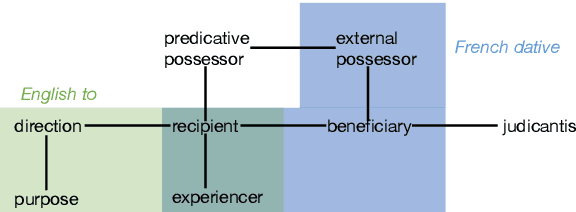


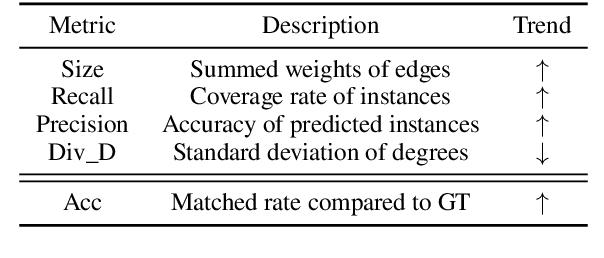
Abstract:Semantic map models (SMMs) construct a network-like conceptual space from cross-linguistic instances or forms, based on the connectivity hypothesis. This approach has been widely used to represent similarity and entailment relationships in cross-linguistic concept comparisons. However, most SMMs are manually built by human experts using bottom-up procedures, which are often labor-intensive and time-consuming. In this paper, we propose a novel graph-based algorithm that automatically generates conceptual spaces and SMMs in a top-down manner. The algorithm begins by creating a dense graph, which is subsequently pruned into maximum spanning trees, selected according to metrics we propose. These evaluation metrics include both intrinsic and extrinsic measures, considering factors such as network structure and the trade-off between precision and coverage. A case study on cross-linguistic supplementary adverbs demonstrates the effectiveness and efficiency of our model compared to human annotations and other automated methods. The tool is available at \url{https://github.com/RyanLiut/SemanticMapModel}.
CoMeDi Shared Task: Models as Annotators in Lexical Semantics Disagreements
Nov 19, 2024



Abstract:We present the results of our system for the CoMeDi Shared Task, which predicts majority votes (Subtask 1) and annotator disagreements (Subtask 2). Our approach combines model ensemble strategies with MLP-based and threshold-based methods trained on pretrained language models. Treating individual models as virtual annotators, we simulate the annotation process by designing aggregation measures that incorporate continuous similarity scores and discrete classification labels to capture both majority and disagreement. Additionally, we employ anisotropy removal techniques to enhance performance. Experimental results demonstrate the effectiveness of our methods, particularly for Subtask 2. Notably, we find that continuous similarity scores, even within the same model, align better with human disagreement patterns compared to aggregated discrete labels.
Reconstructing Global Daily CO2 Emissions via Machine Learning
Jul 29, 2024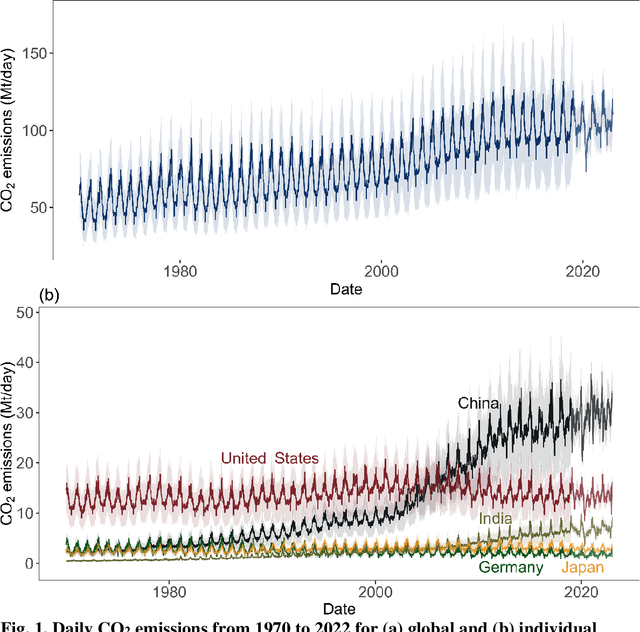

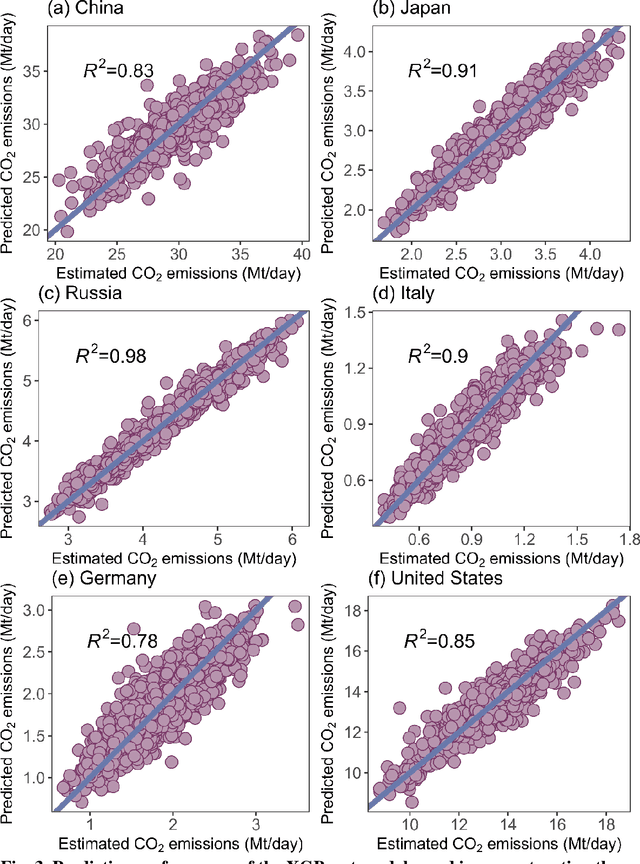
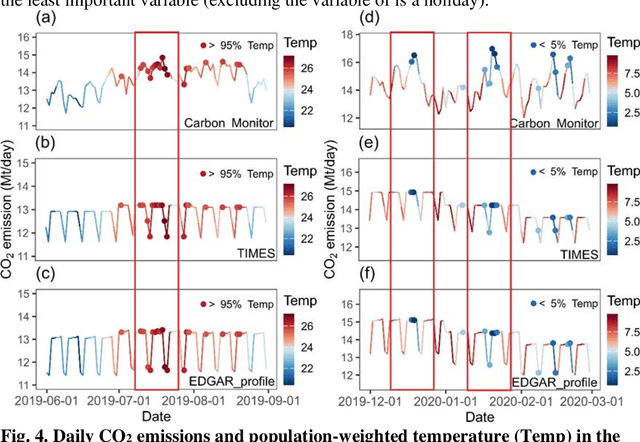
Abstract:High temporal resolution CO2 emission data are crucial for understanding the drivers of emission changes, however, current emission dataset is only available on a yearly basis. Here, we extended a global daily CO2 emissions dataset backwards in time to 1970 using machine learning algorithm, which was trained to predict historical daily emissions on national scales based on relationships between daily emission variations and predictors established for the period since 2019. Variation in daily CO2 emissions far exceeded the smoothed seasonal variations. For example, the range of daily CO2 emissions equivalent to 31% of the year average daily emissions in China and 46% of that in India in 2022, respectively. We identified the critical emission-climate temperature (Tc) is 16.5 degree celsius for global average (18.7 degree celsius for China, 14.9 degree celsius for U.S., and 18.4 degree celsius for Japan), in which negative correlation observed between daily CO2 emission and ambient temperature below Tc and a positive correlation above it, demonstrating increased emissions associated with higher ambient temperature. The long-term time series spanning over fifty years of global daily CO2 emissions reveals an increasing trend in emissions due to extreme temperature events, driven by the rising frequency of these occurrences. This work suggests that, due to climate change, greater efforts may be needed to reduce CO2 emissions.
 Add to Chrome
Add to Chrome Add to Firefox
Add to Firefox Add to Edge
Add to Edge